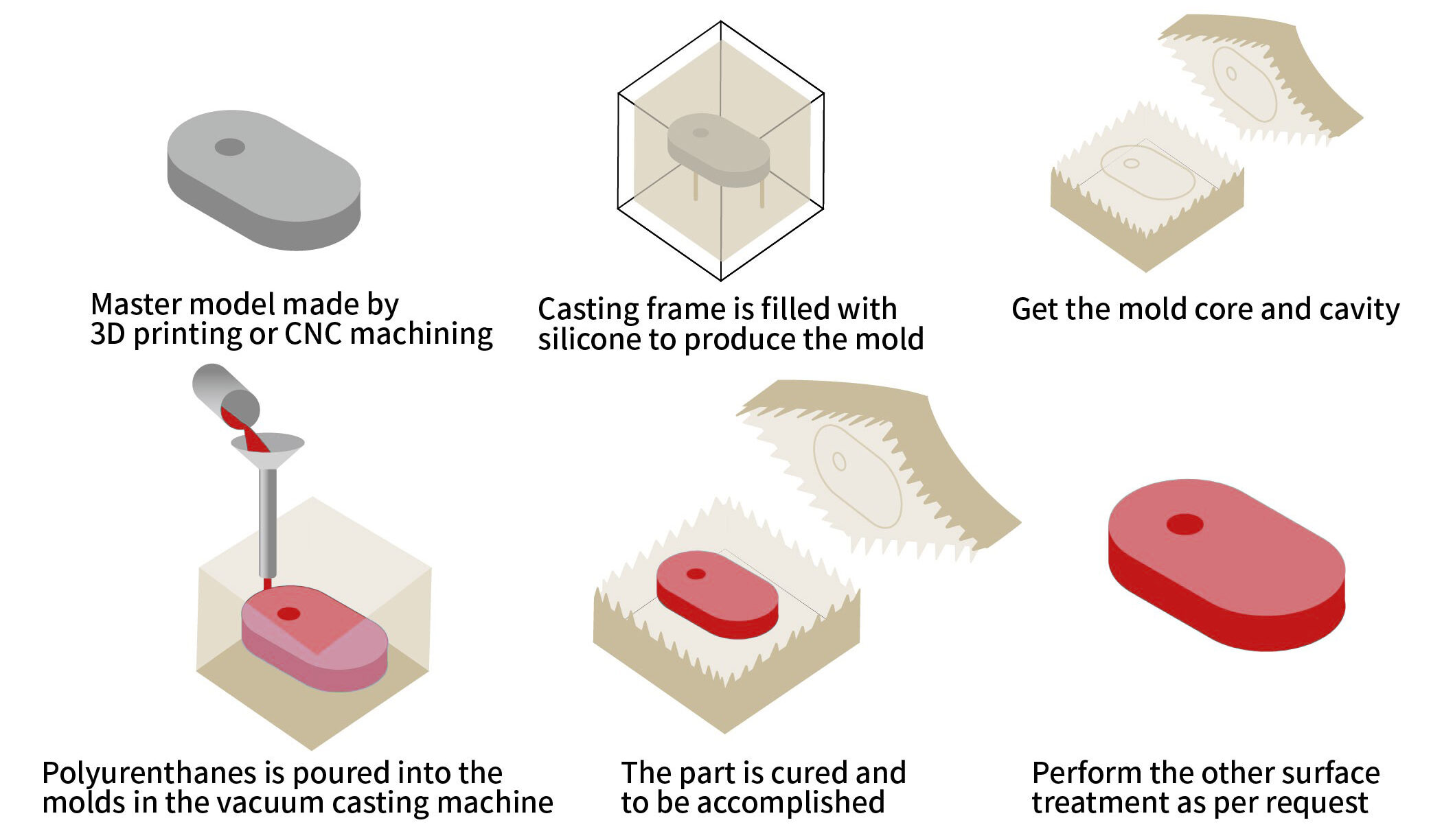What is Vacuum Casting?
The process involves several key steps.
First, a master model or prototype is created using various methods such as 3D printing, CNC machining, or traditional hand sculpting. This master model serves as the basis for creating a silicone mold.
Then, the mold is placed inside a vacuum chamber, and liquid polyurethane resin is poured into it. The vacuum removes any air bubbles and ensures the resin flows evenly and fully fills the mold cavities.
Finally, once the resin cures and solidifies, the mold is opened, and the prototype or part is removed.

Advantages of Vacuum Casting
Cost-Effective: Vacuum casting is a more economical option compared to injection molding when comes to producing small to medium-sized production runs. It eliminates the need for expensive molds, reducing upfront tooling costs and making it a cost-effective solution for low-volume production.
Rapid Prototyping: Vacuum casting enables the rapid production of high-quality prototypes that closely resemble the final product in terms of appearance, functionality, and mechanical properties. This allows designers and engineers to test and validate their designs before committing to expensive mass-production tooling.
Material Versatility: Vacuum casting allows for the use of a variety of polyurethane reins with different mechanical properties. This provides flexibility in selecting materials that meet specific requirements, such as hardness, flexibility, transparency, or heat resistance. It enables the production of parts with varying characteristics, tailored to specific applications.
Complex Geometries and Fine Details: The silicone molds used in vacuum casting can reproduce intricate details and complex geometries with exceptional precision. This makes the process suitable for producing parts with features such as undercuts, thin walls, and fine surface textures that are challenging to achieve through other manufacturing methods.
Speed: Vacuum casting offers relatively short lead times compared to traditional manufacturing methods. Once the mold is prepared, multiple copies of the prototype or part can be produced quickly and efficiently. This speed is especially advantages for meeting tight project deadlines and reducing time-to-market.
Disadvantages of Vacuum Casting
Limited Production Volume Production: While vacuum casting is suitable for low to medium volumes, usually only produces 10 to 50 parts. It may not be the most efficient option for large-scale production runs.
Material Limitations: While vacuum casting provides a wide range of material options within the realm of polyurethane resins, it may not be suitable for producing parts requiring engineering-grade plastics or other specific materials. For applications that demand high-temperature resistance, chemical resistance, or specific material properties, alternative manufacturing methods like injection molding may be more appropriate.
Surface Finish Variations: Vacuum casting generally offers good surface finishes; however, it may not achieve the same level of precision and surface quality as injection molding. Factors such as mold release agents, surface imperfections on the master model, or air entrapment during the casting process can result in slight variations in surface finish from part to part.
Post-processing Requirements: Vacuum-cast parts may require additional post-processing to achieve desired aesthetics or functional requirements. This can involve removing excess material, sanding, painting, or applying other surface treatments to meet specific design or customer expectations.

Applications of Vacuum Casting
The versatility and advantages of vacuum casting make it suitable for a wide range of applications across various industries.
Product Design and Development: Vacuum casting allows designers and engineers to bring their concepts to life quickly and cost-effectively. It facilitates design iterations, testing, and validation of new products before moving into large-scale production.
Automotive and Aerospace: Vacuum casting is used in the automotive and aerospace industries for prototyping complex components, creating low-volume spare parts, and producing customized interior or exterior elements.
Consumer Goods: Vacuum casting is widely used for manufacturing consumer goods such as electronic devices, household appliances, toys, and fashion accessories. It enables the production of high-quality prototypes and small production runs with fast turnaround times.
Medical and Healthcare: Vacuum casting finds applications in the medical field for producing surgical tools, prosthetics, dental models, and other medical devices. It allows for the customization of patient-specific components.
Art and Architecture: Artists and architects utilize vacuum casting to create intricate sculptures, models, and detailed architectural components. It provides the means to reproduce complex designs with high fidelity and consistency.
Conclusion
In conclusion, vacuum casting is a game-changing manufacturing process that has transformed the way prototypes and small-scale production runs are created. With its ability to produce high-quality parts with complex geometries and fine details, vacuum casting offers numerous advantages for businesses seeking efficient and cost-effective manufacturing solutions.
If you’re looking to leverage the power of vacuum casting, HordRT is your ideal partner. As a leading manufacturer of vacuum casting, we bring extensive expertise and cutting-edge technology to meet your manufacturing needs. Our state-of-the-art facilities and skilled professionals enable us to deliver exceptional results with precision and speed.
Taking your manufacturing process to new heights with HordRT’s vacuum casting services. Contact us today to discuss your project requirements and discover how we can help bring your ideas to life with precision, speed, and unmatched quality.
-q4gvl4k29y4hq8j9rjpapvj0ft06fje63olt7p210i.png)

